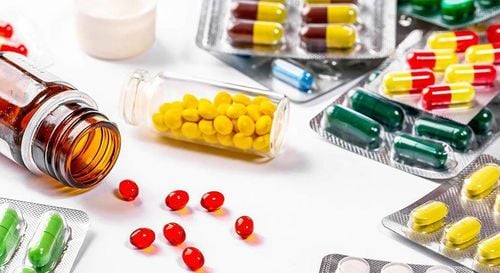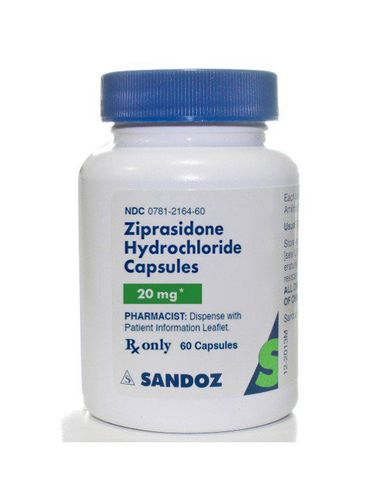This is an automatically translated article.
Stadsidon 20 has the main active ingredient Ziprasidone in the form of Ziprasidone HCl with a strength of 20mg. Stadsidon 20 belongs to the group of psychotropic drugs used to treat schizophrenia, bipolar disorder, ...
1. What is Stadsidon 20?
What is Stadsidon 20? Stadsidon 20 has the main active ingredient Ziprasidone in the form of Ziprasidone HCl with a strength of 20mg. Stadsidon 20 belongs to the group of psychotropic drugs that work to treat schizophrenia, bipolar disorder,...
Stadsidon 20 is made in the form of hard capsules, suitable for direct oral use. Packing is a box of 4 blisters, each blister contains 10 tablets or a medicine box of 6 blisters, each blister contains 7 tablets.
1.1. Pharmacokinetics of Ziprasidone Ziprasidone is an atypical benzyl iso thiazolyl piperazine that can produce antischizophrenia by antagonizing central dopamine D2 receptors and type 2 serotonergic receptors (5). -HT2) central.
1.2. Pharmacokinetics of the active ingredient Ziprasidone Absorption: The active substance Ziprasidone is well absorbed from the gastrointestinal tract. Daily food can double absorption. Time to peak plasma concentrations is 6 to 8 hours after oral administration; for 1 hour by intramuscular route. Dispensing capacity: Dispensing volume: 1.5 L/kg. The binding capacity of the active substance to plasma proteins is approximately 99%. Metabolism: The active substance is metabolised mainly by the liver by aldehyde oxidase. Excretion: The active substance Ziprasidone is excreted mainly as metabolites in faeces (approximately 66%) and urine (approximately 20%). Mean terminal half-life: Approximately 7 hours orally; approximately 2-5 hours by intramuscular route.
2. What diseases does Stadsidon 20 treat?
Stadsidon 20 is used in the treatment of diseases as follows:
Treatment of schizophrenia. Treatment of bipolar disorder type 1. Acute treatment of agitation in people with schizophrenia.
3. Usage and dosage of Stadsidon 20
3.1. How to take Stadsidon 20 Stadsidon 20 is formulated in the form of hard capsules suitable for direct oral use.
3.2. Dosage of Stadsidon 20 Dosage for adults:
Treatment dose for schizophrenia: Initial treatment dose is 20mg x 2 times/day, taken with food. The doctor may prescribe an increase in the dose if necessary at intervals of not less than 2 days, the dose may be increased to 80 mg twice daily. A maintenance dose, 20 mg twice daily, may be effective. Dosage for treatment of bipolar disorder: Initial treatment dose is 40mg x 2 times/day, taken with food. On the second day, increase the therapeutic dose to 80 or 80 mg twice daily, then adjust the maintenance dose according to response. Drug users need to continue treatment at the dose they are receiving stable treatment, in the range of 40 - 80 mg x 2 times / day. Dose for acute agitation in people with schizophrenia: Up to 80 mg twice daily as an alternative to intramuscular injections in the maintenance treatment of agitation in psychotic patients. schizophrenic. Dosage in children:
The efficacy and safety of Ziprasidone have not been established in children under 18 years of age. Dosage in the elderly:
There were no clinically important differences between the use of the drug and the elderly and adults. Dosage for patients with renal and hepatic impairment:
No dose adjustment is required. 3.3. Overdosage of Stadsidon 20 There are limited data on overdoses of Stadsidon 20. Some of the most common signs and symptoms following an overdose such as extrapyramidal symptoms, somnolence, tremor and anxiety, increased visual acuity, convulsions or dystonia of the head and neck occurred after overdose. dose by inhalation, accompanied by vomiting. The treating doctor will order a cardiac examination and an electrocardiogram to detect arrhythmias early. Treatment: Currently, there is no specific antidote for Stadsidon 20 overdose.
4. Undesirable effects of Stadsidon 20
During the use of Stadsidon 20, you may experience common undesirable effects such as:
Whole body: flu syndrome, fever, facial edema, chills, sensitivity to light, abdominal pain, pain ribs, hypothermia, causing an accident while driving. For the cardiovascular system: Tachycardia, hypertension, orthostatic hypotension. For the digestive system: Anorexia, vomiting. For the musculoskeletal system: Muscle pain. Less common undesirable effects are as follows:
For the cardiovascular system: Bradycardia, atrial fibrillation, angina. For the digestive system: Rectal bleeding, difficulty swallowing, tongue edema. For blood and lymph: Anemia, rapid bruising, increased or decreased white blood cell count, increased eosinophil count, lymphadenopathy. Metabolism and nutrition: Thirst, increased transaminase index, peripheral angioedema, increased blood glucose, increased creatinine phosphokinase index, increased alkaline phosphate, increased blood cholesterol, dehydration, increased lactic dehydrogenase, albuminuria, decreased potassium in the blood. For the musculoskeletal system: Tendonitis. Rare adverse effects, including the following:
For the cardiovascular system: First degree atrioventricular block (AV block), bundle branch block, phlebitis, pulmonary embolism, cardiomegaly, cerebral infarction, stroke cerebrovascular, deep vein thrombosis, myocarditis, thrombophlebitis. For the digestive system: Bleeding teeth, jaundice, constipation, increased gamma glutamyl transpeptidase, vomiting blood, cholestatic jaundice, hepatitis, hepatomegaly, oral leukoplakia, black stools. Endocrine: hypothyroidism, hyperthyroidism or thyroiditis. Blood and lymph: Decreased platelet count, hypopigmentation anemia, increased lymphocytes in the blood, increased number of monocytes, increased basophils, lymphedema, polycythemia vera, thrombocytopenia.
5. Interactions of Stadsidone 20
Stadsidon 20 drug interactions may occur as follows:
Use of Stadsidon 20 may enhance the effect of other CNS depressants and some antihypertensive drugs. Administration of Stadsidone 20 alters the metabolism with inducers of CYP3A4 (eg, carbamazepine) and inhibitors (eg, ketoconazole). Potentially Fatal: Increased risk of arrhythmias with specific QT-prolonging drugs such as Dofetilide, Quinidine, Sotalol, other Class I and III antiarrhythmics, Moxifloxacin, Pimozide, Sparfloxacin, Thioridazine). Absorption is increased by 2 times when Stadsidon 20 is taken with food. Increased CNS effects when using Stadsidon 20 with alcohol.
6. Some notes when using Stadsidon 20
6.1. Contraindications of Stadsidon 20 People with hypersensitivity or sensitivity to any of the ingredients of the drug. Ziprasidone is contraindicated in patients with a history of QT prolongation in acute myocardial infarction or in uncompensated heart failure. Pharmacodynamic/pharmacokinetic studies between Stadsidone 20 and drugs known to prolong the QT interval have not been performed. The synergistic effects between Stadsidon 20 and these drugs cannot be ruled out. Therefore, Stadsidon 20 should not be used with drugs: Dofetilid, Sotalol, Quinidine, antiarrhythmic drugs Tacrolimus,... 6.2. Precautions when using Stadsidon 20 Increased risk of death in the elderly with mental illness related to memory disorders: Elderly people with mental illness related to memory disorders treated with antipsychotic drugs Psychosis has a high mortality risk. QT interval prolongation and risk of sudden death: Stadsidone 20 should not be combined with drugs known to prolong the QT interval. Neuroleptic malignant syndrome (NMS): A fatal syndrome requiring immediate discontinuation and intensive treatment, has been reported in people treated with antipsychotics, including rarely in combination. with drug treatment Stadsidon 20 . Increased blood sugar and diabetes: In some severe cases, the combination of treatment with atypical antipsychotic ketoacidosis, deep coma or death. 6.3. Use in pregnancy and lactation Pregnancy: There are currently no studies on the safety of use in pregnant women. Stadsidon 20 should be used during pregnancy only after the benefit of treatment has been weighed against the risk to the fetus. Lactation: It is not known whether Stadsidon 20 is excreted through human breast milk or not. You should actively discontinue breast-feeding while using Stadsidon 20. Effects on ability to drive and use machines: Stadsidon 20 may cause increased drowsiness, affecting the ability to drive and use machines. hook. When using the drug, if you want to drive or operate machinery, you need to be very careful. Above is all information about Stadsidon 20, patients need to carefully read the instructions for use, consult a doctor / pharmacist before use. Absolutely do not arbitrarily buy Stadsidon 20 to treat the disease at home, because there may be unwanted side effects on health.
Follow Vinmec International General Hospital website to get more health, nutrition and beauty information to protect the health of yourself and your loved ones in your family.
Please dial HOTLINE for more information or register for an appointment HERE. Download MyVinmec app to make appointments faster and to manage your bookings easily.













